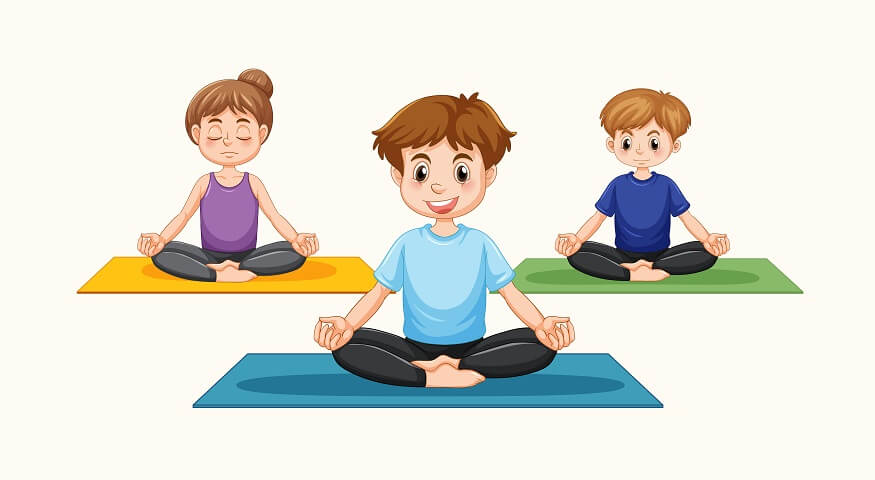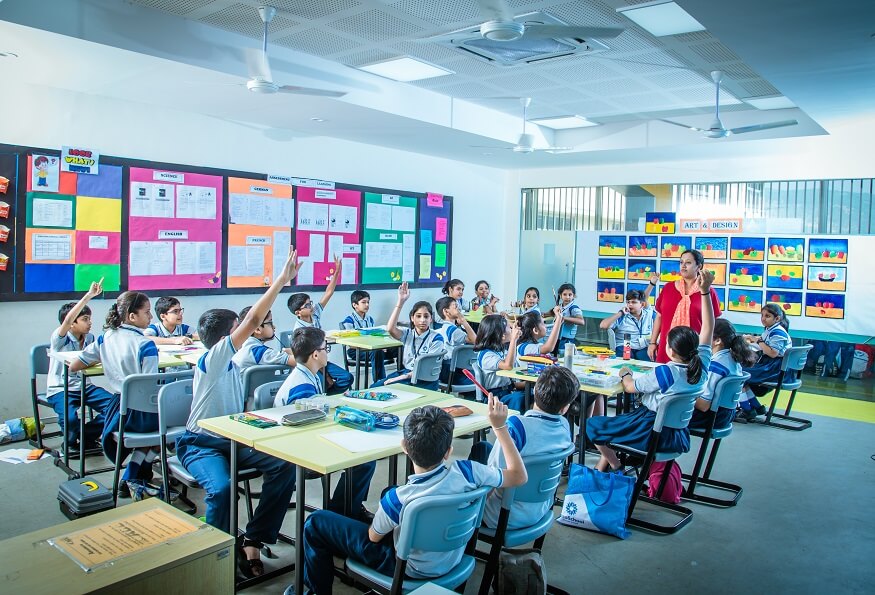Mindfulness education for school students refers to the integration of mindfulness practices and techniques into the school curriculum and daily routines. In order to help students to create awareness and focus on the present moment, it involves teaching them various mindfulness activities, including breathing exercises, guided meditations, and body scans. It involves listening to their stories without passing judgement.
Visualise you are sitting on a bench, and now your teacher instructs you to close your eyes and pay attention to your breathing. Then you start to notice how the air feels entering and leaving your body. You get the ability to be more aware of your thoughts and sensations while preventing yourself from being dragged into them by doing this. You observe them as if they were clouds passing across the sky while knowing they come and go.
Instead of freaking out or feeling helpless during a challenging exam, you take a minute to relax, breathe thoroughly, and refresh your attention to the subject at hand. By being fully present, you can approach the exam with clarity and focus, making it easier to recall information and answer questions accurately.
Imagine you are one of the team members in a sports team and you make a mistake that results in your team dropping a score. Instead of getting upset or frustrated, you take a mindful pause, acknowledging your feelings, and then refocusing on the game. This helps you recover quickly, learn from the mistake, and perform better in the next moments.
Purpose Of Mindfulness Activity:
The important goal of mindfulness classrooms and activities is to develop present-moment awareness and observations, emotions, and senses without passing judgement. It highlights well-being, reduces stress, increases attention, and develops a stronger feeling of clarity and tranquillity in daily life. Studies reveal that mindfulness in schools significantly improves students’ mental health.
How to Practice Mindfulness:
Find a quiet space:
Choose a calm and quiet environment where you can comfortably practice mindfulness without distractions.
Begin with deep breathing:
Take a deep breath to get started, concentrating on how your breath feels entering and exiting your body. Focus on your abdomen’s rise and fall or the sensation of air entering your nose.
Body scan:
Pay attention to your body from head to toe, gradually moving your awareness through each body part. Direct your attention towards any bodily sensations that you may be experiencing at present, perhaps there may be areas of tension or relaxation that you notice. Observing these aspects without holding onto judgement is a valuable practice in developing mindfulness.
Observing thoughts and emotions:
Allow thoughts and emotions to arise without getting caught up in them. Observe them as if they are passing clouds, acknowledging their presence and letting them go.
Engage your senses in the present:
Do this by focusing on your senses. Keep an eye out for the visuals, sounds, tastes, and scents in the area. Cherish every event with complete presence.
Practice gratitude:
Develop an attitude of appreciation by pausing to consider your blessings. It might be as straightforward as enjoying a lovely sunset, a delectable dinner, or the company of loved ones.
Mindful activities:
Include mindfulness in routine tasks like eating, walking, and even dishwashing. Pay close attention to the movements, tastes, scents, and feelings that come with these activities.
Guided meditations:
Use guided meditations or mindfulness apps that provide step-by-step instructions to help you practice mindfulness. These resources offer a structured approach and can be especially helpful for beginners.
Remember, mindfulness is a skill that develops with regular practice. To ensure your comfort and safety it is best to begin with shorter meditation sessions and slowly work your way up to longer periods. This approach helps you build endurance at a pace that feels right for you. Consistency is key, so try to incorporate mindfulness into your daily routine to experience its benefits fully.
Significance of Mindfulness in Schools Research
The National Mental Health Survey revealed that 10–20% of Indian students suffer from mental health. According to studies conducted in India, students who take mindfulness education showed improvements in their cognitive abilities and memory skills, which enhanced their academic performance.
50 per cent of Indian students reported having mental distress, according to the Global School-based Student Health Survey. Training with mindfulness has been shown to improve emotional control abilities, decrease negative emotions, and encourage general well-being.
The Research involving elementary school students showed that mindfulness classroom training had some amazing outcomes. The kids who took part in the mindfulness program showed an increase in their focus, emotional control, and peaceful dispute resolution. Even more touching is the fact that the classroom climate improved as a result of the student’s greater collaboration and empathy for one another. It is extremely wonderful to observe how mindfulness can significantly improve the lives of young kids, fostering their mental health and fostering a positive learning environment.
Benefits of Mindfulness Education:
Stress reduction:
By encouraging rest, relaxing the mind, and developing an awareness of inner peace, mindfulness reduces stress. It allows individuals to respond to stressors with greater resilience and equanimity.
Increased self-awareness:
Mindfulness practises helps people in being more conscious of their thoughts, feelings, and behaviours. Mindfulness classroom in schools encourages self-evaluation, reflective behaviour, and the development of a deeper understanding of oneself.
Enhanced focus and attention:
Regular mindfulness practice improves concentration and attention span. It enhances cognitive skills, memory retention, and the ability to stay present and focused on various tasks and activities.
Emotional regulation:
Mindfulness classroom training cultivates greater awareness of one’s emotions and helps students develop healthier ways of managing and responding to them. It fosters emotional resilience and equips individuals with the tools to navigate challenging emotions effectively.
Better relationships:
Mindfulness practice can improve interpersonal relationships by enhancing empathy, compassion, and active listening skills. It encourages acceptance, comprehension, and efficient communication.
Physical well-being:
Mindfulness has been connected to various physical health benefits, including reduced blood pressure, Deep sleep, and boosted immune system functioning. It encourages a healthier lifestyle and self-care practices.
Overall well-being and happiness:
Regular engagement in mindfulness activities contributes to an increased sense of overall well-being and life satisfaction. It helps individuals find joy and contentment in the present moment, fostering a positive outlook on life.
Conclusion:
At EuroSchool, we are aware of the benefits of mindfulness in schools as students who take mindfulness education are better able to manage their emotions, activate their inner feelings, and make intelligent decisions throughout their daily lives. Mindfulness in schools research consistently demonstrates its profound impact on students’ well-being, academic performance, and overall development. The transformative power of mindfulness education is evident, making it a major component of modern education, benefiting both students and the entire school community.











